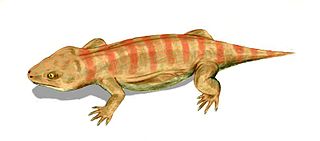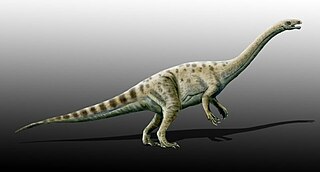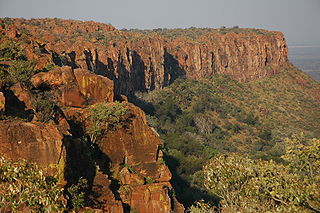
Abrictosaurus is a genus of heterodontosaurid dinosaur that lived during the Early Jurassic in what is now in parts of southern Africa such as Lesotho and South Africa. It was a bipedal herbivore or omnivore and was one of the most basal heterodontosaurids. It was approximately 1.2 metres (3.9 ft) long and weighed between 0.68 and 3 kilograms.

Massospondylus was a genus of sauropodomorph dinosaur from the Early Jurassic. It was described by Sir Richard Owen in 1854 from remains discovered in South Africa, and is thus one of the first dinosaurs to have been named. Fossils have since been found at other locations in South Africa, Lesotho, and Zimbabwe. Material from Arizona's Kayenta Formation, India, and Argentina has been assigned to the genus at various times, but the Arizonan and Argentinian material are now assigned to other genera.

Blikanasaurus is a genus of sauropodomorph dinosaur from the late Triassic of South Africa. The generic name Blikanasaurus is derived from Greek, meaning "lizard from Blikana". The species name cromptoni is taken from the surname of A.W. "Fuzz" Crompton, an American paleontologist who led numerous field expeditions in Elliot Formation outcrop localities in South Africa. Blikanasaurus is only known from partial hindlimb bones that were recovered from the lower Elliot Formation (LEF) in the Eastern Cape.

Euskelosaurus is a sauropodomorph dinosaur from the Late Triassic of South Africa and Lesotho. Fossils have only been recovered from the lower Elliot Formation in South Africa and Lesotho, and in one locality in Zimbabwe.

Sphenosuchus is an extinct genus of crocodylomorph from the Early Jurassic Elliot Formation of South Africa, discovered and described early in the 20th century. The skull is preserved very well but other than elements of the forelimb and isolated parts of the hind limb, the Sphenosuchus material is incomplete. It was probably quadrupedal, but may have been a facultative biped.

Procolophon is a genus of lizard-like procolophonid parareptiles that first appeared in the Early Triassic (Induan) of South Africa, Brazil, and Antarctica. It persisted through the Permian–Triassic extinction event, but went extinct in the beginning of the Early Middle Triassic. The type species is P. trigoniceps.

The Clarens Formation is a geological formation found in several localities in Lesotho and in the Free State, KwaZulu-Natal, and Eastern Cape provinces in South Africa. It is the uppermost of the three formations found in the Stormberg Group of the greater Karoo Supergroup rocks and represents the final phase of preserved sedimentation of the Karoo Basin.

Massospondylidae is a family of early massopod dinosaurs that existed in Asia, Africa, North America, South America and Antarctica during the Late Triassic to the Early Jurassic periods. Several dinosaurs have been classified as massospondylids over the years. The largest cladistic analysis of early sauropodomorphs, which was presented by Apaldetti and colleagues in November 2011, found Adeopapposaurus, Coloradisaurus, Glacialisaurus, Massospondylus, Leyesaurus and Lufengosaurus to be massospondylids. This result supports many previous analyses that tested fewer taxa. However, this analysis found the two recently described North American massopods, Sarahsaurus and Seitaad, and the South African Ignavusaurus to nest outside Massospondylidae, as opposed to some provisional proposals. Earlier in 2011, Pradhania, a sauropodomorph from India, was tested for the first time in a large cladistic analysis and was found to be a relatively basal massospondylid. Mussaurus and Xixiposaurus may also be included within Massospondylidae.
Paleontology or palaeontology is the study of prehistoric life forms on Earth through the examination of plant and animal fossils. This includes the study of body fossils, tracks (ichnites), burrows, cast-off parts, fossilised feces (coprolites), palynomorphs and chemical residues. Because humans have encountered fossils for millennia, paleontology has a long history both before and after becoming formalized as a science. This article records significant discoveries and events related to paleontology that occurred or were published in the year 2006.

The Elliot Formation is a geological formation and forms part of the Stormberg Group, the uppermost geological group that comprises the greater Karoo Supergroup. Outcrops of the Elliot Formation have been found in the northern Eastern Cape, southern Free State, and in the eastern KwaZulu-Natal provinces of South Africa. Outcrops and exposures are also found in several localities in Lesotho such as Qacha's Neck, Hill Top, Quthing, and near the capital, Maseru. The Elliot Formation is further divided into the lower (LEF) and upper (UEF) Elliot formations to differentiate significant sedimentological differences between these layers. The LEF is dominantly Late Triassic (Norian-Hettangian) in age while the UEF is mainly Early Jurassic (Sinemurian-Pliensbachian) and is tentatively regarded to preserve a continental record of the Triassic-Jurassic boundary in southern Africa. This geological formation is named after the town of Elliot in the Eastern Cape, and its stratotype locality is located on the Barkly Pass, 9 km north of the town.

Clevosaurus is an extinct genus of rhynchocephalian reptile from the Late Triassic and the Early Jurassic periods. Species of Clevosaurus were widespread across Pangaea, and have been found on all continents except Australia and Antarctica. Five species of Clevosaurus have been found in ancient fissure fill deposits in south-west England and Wales, alongside other sphenodontians, early mammals and dinosaurs. In regards to its Pangaean distribution, C. hadroprodon is the oldest record of a sphenodontian from Gondwana, though its affinity to Clevosaurus has been questioned.
Notochampsa is an extinct genus of protosuchian crocodyliform. Fossils have been found from the lower Clarens Formation of the Karoo Supergroup in South Africa, dating back to the Pliensbachian stage of the Early Jurassic. Notochampsa comes from a period of relative fossil scarcity, and is the youngest known occurrence of a crocodylomorph from the Karoo Basin of South Africa.
Christian Alfred Sidor is an American vertebrate paleontologist. He is currently a Professor in the Department of Biology, University of Washington in Seattle, as well as Curator of Vertebrate Paleontology and Associate Director for Research and Collections at the Burke Museum of Natural History and Culture. His research focuses on Permian and Triassic tetrapod evolution, especially on therapsids.

The Stormberg Group is one of the four geological groups that comprises the Karoo Supergroup in South Africa. It is the uppermost geological group representing the final phase of preserved sedimentation of the Karoo Basin. The Stormberg Group rocks are considered to range between Lower Triassic (Olenekian) to Lower Jurassic (Pliensbachian) in age. These estimates are based on means of geological dating including stratigraphic position, lithostratigraphic and biostratigraphic correlations, and palynological analyses.

Megapnosaurus is an extinct genus of coelophysid theropod dinosaur that lived approximately 188 million years ago during the early part of the Jurassic Period in what is now Africa. The species was a small to medium-sized, lightly built, ground-dwelling, bipedal carnivore, that could grow up to 2.2 m (7.2 ft) long and weigh up to 13 kg (29 lb).

Pentasaurus is an extinct genus of dicynodont of the family Stahleckeriidae, closely related to the well known Placerias. It was found in the Lower Elliot Formation of South Africa, dated to the Norian of the Late Triassic period. The genus contains the type and only species, Pentasaurus goggai. Pentasaurus is named after the ichnogenus Pentasauropus, fossil footprints that were originally described from the lower Elliot Formation in 1970 decades before the body fossils of Pentasaurus itself were recognised. Pentasauropus footprints were likely made by dicynodonts, and in South Africa Pentasaurus itself was the likely trackmaker. The name reflects the fact that a large dicynodont was predicted to have existed in the lower Elliot Formation before any body fossils were recognised, and so Pentasaurus was named after its probable footprints. This is a reversal of the more typical occurrence where fossil footprints are named after their presumed trackmakers. The name of the species honours its collector Alfred Brown, nicknamed "Gogga", which means "bug" in Afrikaans.

The Omingonde Formation is an Early to Middle Triassic geologic formation, part of the Karoo Supergroup, in the western Otjozondjupa Region and northeastern Erongo Region of north-central Namibia. The formation has a maximum thickness of about 600 metres (2,000 ft) and comprises sandstones, shales, siltstones and conglomerates, was deposited in a fluvial environment, alternating between a meandering and braided river setting.
Scalenodontoides is an extinct genus of Traversodontidae, a family of herbivorous cynodonts. It lived during the Late Triassic in what is now South Africa. Its type species is Scalenodontoides macrodontes. It was named in 1957 by A. W. Crompton and F. Ellenberger. Arctotraversodon plemmyrodon was originally classified as a species of Scalenodontoides, but was given its own genus in 1992. It is found in the Scalenodontoides Assemblage Zone of the Elliot Formation, which is named for it. It is one of the geologically youngest traversodontids, alongside the putative traversodontid Boreogomphodon. It is closely related to Exaeretodon and Siriusgnathus, but is distinguished by the presence of a shelf-like expansion of its parietal called the nuchal table. Though the largest known complete skull is only 248 millimetres (9.8 in) long, it may have been the largest non-mammalian cynodont, as an incomplete snout would have belonged to a specimen with an estimated skull length of 617 millimetres (24.3 in).



















